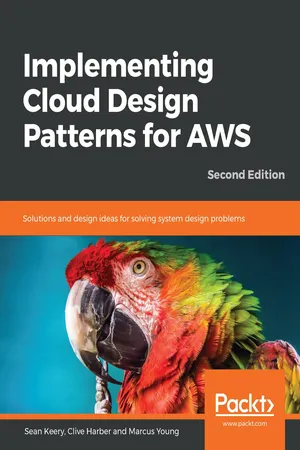
Implementing Cloud Design Patterns for AWS
Solutions and design ideas for solving system design problems, 2nd Edition
- 274 pages
- English
- ePUB (mobile friendly)
- Available on iOS & Android
Implementing Cloud Design Patterns for AWS
Solutions and design ideas for solving system design problems, 2nd Edition
About This Book
Create highly efficient design patterns for scalability, redundancy, and high availability in the AWS Cloud
Key Features
- Build highly robust systems using the cloud infrastructure
- Make web applications resilient against scheduled and accidental downtime
- Explore and apply Amazon-provided services in unique ways to solve common design problems
Book Description
Whether you're just getting your feet wet in cloud infrastructure or already creating complex systems, this book will guide you through using the patterns to fit your system needs.
Starting with patterns that cover basic processes such as source control and infrastructure-as-code, the book goes on to introduce cloud security practices. You'll then cover patterns of availability and scalability and get acquainted with the ephemeral nature of cloud environments. You'll also explore advanced DevOps patterns in operations and maintenance, before focusing on virtualization patterns such as containerization and serverless computing. In the final leg of your journey, this book will delve into data persistence and visualization patterns. You'll get to grips with architectures for processing static and dynamic data, as well as practices for managing streaming data.
By the end of this book, you will be able to design applications that are tolerant of underlying hardware failures, resilient against an unexpected influx of data, and easy to manage and replicate.
What you will learn
- Implement scaling policies on schedules, influxes in traffic, and deep health checks
- Make complete use of highly available and redundant storage
- Design content delivery networks to improve user experience
- Optimize databases through caching and sharding
- Apply patterns to solve common problems
- Implement repeatable processes for deploying systems
Who this book is for
If you're an architect, solution provider, or DevOps community member looking to implement repeatable patterns for deploying and maintaining services in the Amazon cloud infrastructure, this book is for you.
You'll need prior experience of using AWS understand key concepts covered in the book, as it focuses on the patterns rather than the basics of using AWS.
Frequently asked questions
Information
Section 1: The Basics
- Chapter 1, Introduction to Amazon Web Services
- Chapter 2, Core Services – Building Blocks for Your Product
- Chapter 3, Availability Patterns – Understanding Your Needs
- Chapter 4, Security – Ensuring the Integrity of Your Systems
Introduction to Amazon Web Services
- Introduction to AWS
- Utility computing
- Categories of service offerings
- Benefits of moving to the cloud
Introduction to AWS
History
The future
Product
Data
Code
Utility computing
Anything as a Service
Table of contents
- Title Page
- Copyright and Credits
- Dedication
- About Packt
- Contributors
- Preface
- Section 1: The Basics
- Introduction to Amazon Web Services
- Core Services - Building Blocks for Your Product
- Availability Patterns - Understanding Your Needs
- Security - Ensuring the Integrity of Your Systems
- Section 2: DevOps Patterns
- Continuous Deployment - Introducing New Features with Minimal Risk
- Ephemeral Environments - Sandboxes for Experiments
- Operation and Maintenance - Keeping Things Running at Peak Performance
- Application Virtualization - Using Cloud Native Patterns for Your Workloads
- Antipatterns - Avoiding Counterproductive Solutions
- Section 3: Persistence Patterns
- Databases - Identifying Which Type Fits Your Needs
- Data Processing - Handling Your Data Transformation
- Observability - Understanding How Your Products Are Behaving
- Anti-Patterns - Bypassing Inferior Options
- Other Books You May Enjoy